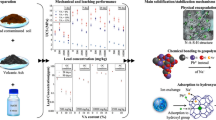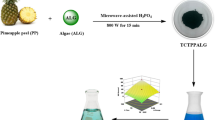Abstract
A high level of maize production in India has caused algae biomass to form, which is polluting the environment. In recent years, maize husks have become more commonly used as animal feed, whereas maize cobs have not. There is a lot of silica in a material with a 66% silica content. The silica found in biomass ash of Chlorophyta algae can be used to produce silica gel. The purpose of this study is to make and characterize a silica gel derived from corncob ash and to test its adsorption capacity against copper ions (II). Silica gel can be prepared using the sol–gel method, which has proven extremely effective. Fourier transform infrared and X-ray diffraction methods were used to characterize silica gel properties. A study that synthesized silica gel using sulfuric acid and acetic acid found that each acid had a water content of 14% and 12%, respectively. According to FTIR- and XRD-based characterizations, the synthesized silica gel has similar functional groups and crystallinity to Kiesel Gel 60G. In comparison to Kiesel Gel 60G or silica gel synthesized with acetic acid, silica gel synthesized with sulfuric acid has a higher adsorption power and efficiency. The novelty of the study is to address environmental pollution resulting from maize production in India. By repurposing underutilized maize cobs and algae biomass ash, a silica gel with high silica content is synthesized via the sol–gel method. Characterization using Fourier transform infrared and X-ray diffraction techniques reveals comparable properties to commercial silica gel. Significantly, silica gel synthesized with sulfuric acid exhibits superior adsorption capacity for copper ions compared to established methods. This innovative study not only offers a sustainable solution to mitigate pollution but also advances the understanding of silica gel synthesis and its potential applications in the environment.







Similar content being viewed by others
Data availability
The data used to support the findings of this study are included in the article.
References
Deniz F, Ersanli ET (2018) A natural macroalgae consortium for biosorption of copper from aqueous solution: optimization, modelling, and design studies. Int J Phytoremed 20:362–368
Jiang F, Yin S, Zhang L et al (2018) Solvent extraction of Cu(II) from sulfate solutions containing Zn(II) and Fe(III) using an interdigital micromixer. Hydrometallurgy 177:116–122
Moscatello N, Swayambhu G, Jones CH (2018) Continuous removal of copper, magnesium, and nickel from industrial wastewater utilizing the natural product yersiniabactin immobilized within a packed-bed column. Chem Eng J 343:173–179
Al-Saydeh SA, El-Naas MH, Zaidi SJ (2017) Copper removal from industrial wastewater: A comprehensive review. J Ind Eng Chem 56:35–44
Hackbarth FV, Girardi F, De Sousa AAU (2015) Ion exchange prediction model for multi-metal system obtained from single-metal systems using the macroalga Pelvetia canaliculata (Phaeophyceae) as a natural cation exchanger. Chem Eng J 260:694–705
Elshkaki A, Graedel TE, Ciacci L (2016) Copper demand, supply, and associated energy use to 2050. Global Environ Change 39:305–315
Xu SY, Huang X, Cheong KL (2017) Recent advances in marine algae polysaccharides: isolation, structure, and activities. Mar Drugs 15:388
Fertah M, Belfkira A, Dahmane E et al (2017) Extraction and characterization of sodium alginate from Moroccan Laminaria digitata brown seaweed. Arabian J Chem 10:3707–3714
Deniz F, Karabulut A (2017) Biosorption of heavy metal ions by chemically modified biomass of coastal seaweed community: studies on phytoremediation system modelling and design. Ecol 106:101–108
Mahmoodi NM, Keshavarzi S, Ghezelbash M (2017) Synthesis of nanoparticle and modelling of its photocatalytic dye degradation ability from colored wastewater, Journal of Environmental. Chem Eng 5:3684–3689
Mahmoodi NM, Keshavarzi S, Ghezelbash M (2017) Synthesis of nanoparticle and modelling of its photocatalytic dye degradation ability from colored wastewater. J Environ Chem Eng 5(4):3684–3689
Mahmoodi NM, Karimi B, Mazarji M, Moghtaderi M (2018) Cadmium selenide quantum dot-zinc oxide composite: synthesis, characterization, dye removal ability with UV irradiation, and antibacterial activity as a safe and high-performance photocatalyst. J Photochem Photobiol B 188:19–27
Shourijeh ZM, Langari S, Montazerghaem L, Mahmoodi NM (2020) Synthesis of porous aminated PAN/PVDF composite nanofibers by electrospinning: characterization and Direct Red 23 removal. J Environ Chem Eng 8(4):103876
Aqdam SR, Otzen DE, Mahmoodi NM, Morshedi D (2021) Adsorption of azo dyes by a novel bionanocomposite based on whey protein nanofibrils and nano-clay: equilibrium isotherm and kinetic modelling. J Colloid Interface Sci 602:490–503
Bagheri A, Hoseinzadeh H, Hayati B, Mahmoodi NM, Mehraeen E (2016) Post-synthetic functionalization of the metal-organic framework: clean synthesis, pollutant removal, and antibacterial activity. J Environ Chem Eng 9(1):104590
Mahmoodi NM, Mokhtari-Shourijeh Z (2016) Preparation of aminated nanoporous nanofiber by solvent casting/porogen leaching technique and dye adsorption modelling. J Taiwan Inst Chem Eng 65:378–389
Mahmoodi NM, Mokhtari-Shourijeh Z (2016) Modified poly(vinyl alcohol)-triethylenetetramine nanofiber by glutaraldehyde: preparation and dye removal ability from wastewater. Desalin Water Treat 57:20076–20083
Hosseinabadi-Farahani Z, Hosseini-Monfared H, Mahmoodi NM (2015) Graphene oxide nanosheet: preparation and dye removal from binary system colored wastewater. Desalin Water Treat 56:2382–2394
Hosseinabadi-Farahani Z, Mahmoodi NM, Hosseini-Monfared H (2015) Preparation of surface functionalized graphene oxide nanosheet and its multicomponent dye removal ability from wastewater. Fibers Polym 16:1035–1047
Mahmoodi NM, Hosseinabadi-Farahani Z, Chamani H (2017) Dye adsorption from single and binary systems using NiO-MnO2 nanocomposite and artificial neural network modelling. Environ Prog Sustain Energy 36:111–119
Mahmoodi NM, Maghsoodi A (2015) Kinetics and isotherm of cationic dye removal from multicomponent system using the synthesized silica nanoparticle. Desalin Water Treat 54:562–571
Rabeie B, Mahmoodi NM (2024) Heterogeneous MIL-88A on MIL-88B hybrid: a promising eco-friendly hybrid from green synthesis to dual application (Adsorption and photocatalysis) in tetracycline and dyes removal. J Colloid Interface Sci 654:495–522
Hosseini SH, Vossoughi M, Mahmoodi NM, Sadrzadeh M (2019) Clay-based electrospun nanofibrous membranes for colored wastewater treatment. Appl Clay Sci 168:77–86
Author information
Authors and Affiliations
Contributions
Karthikeyan—writing, original draft, conceptualization, review, and editing.
Ekrem Yanmaz—supervision and methodology.
Corresponding author
Ethics declarations
Ethical approval
Not applicable.
Competing interests
The authors declare no competing interests.
Additional information
Publisher's Note
Springer Nature remains neutral with regard to jurisdictional claims in published maps and institutional affiliations.
This study was performed as a part of the employment of institutions.
Rights and permissions
Springer Nature or its licensor (e.g. a society or other partner) holds exclusive rights to this article under a publishing agreement with the author(s) or other rightsholder(s); author self-archiving of the accepted manuscript version of this article is solely governed by the terms of such publishing agreement and applicable law.
About this article
Cite this article
Sathasivam, K., Yanmaz, E. Synthesis of a Cu (II) metal ion adsorbent from biomass ash of Chlorophyta algae. Biomass Conv. Bioref. (2024). https://doi.org/10.1007/s13399-024-05693-0
Received:
Revised:
Accepted:
Published:
DOI: https://doi.org/10.1007/s13399-024-05693-0




